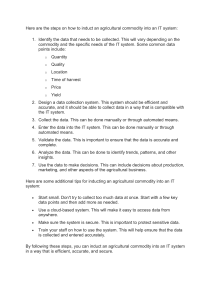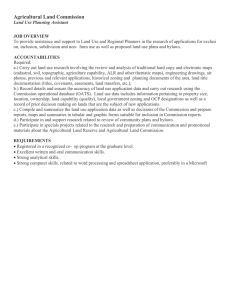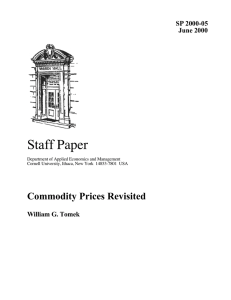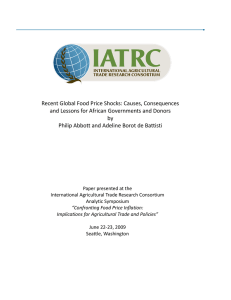AG-ECO NEWS Jose G. Peña
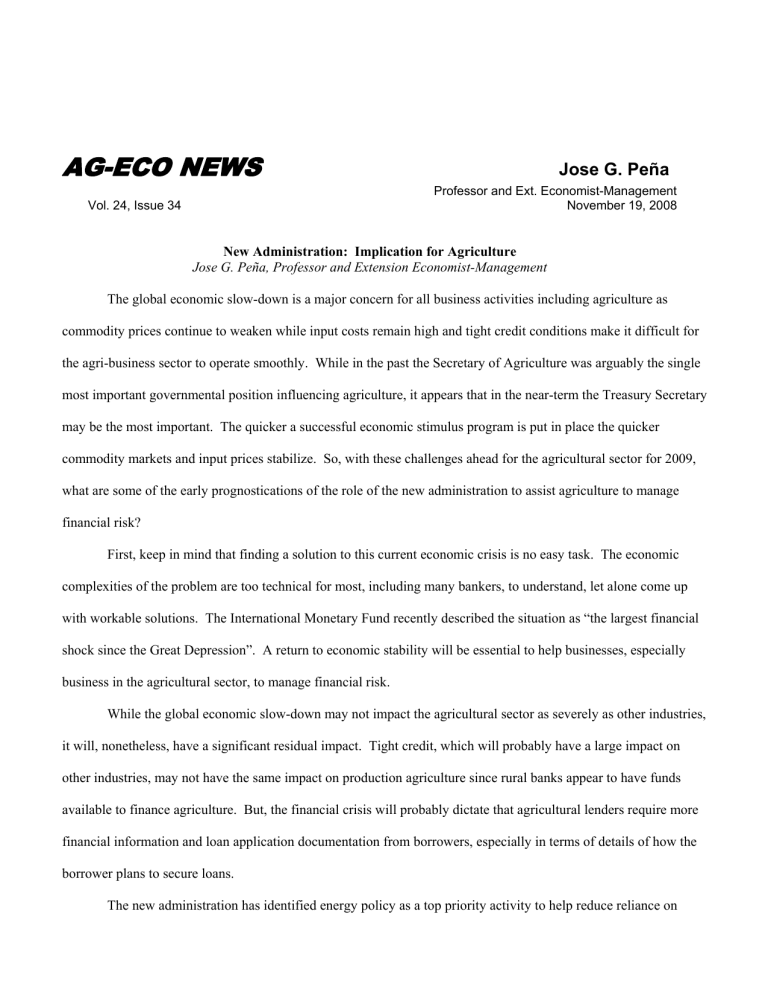
AG-ECO NEWS
Jose G. Peña
Professor and Ext. Economist-Management
Vol. 24, Issue 34 November 19, 2008
New Administration: Implication for Agriculture
Jose G. Peña, Professor and Extension Economist-Management
The global economic slow-down is a major concern for all business activities including agriculture as commodity prices continue to weaken while input costs remain high and tight credit conditions make it difficult for the agri-business sector to operate smoothly. While in the past the Secretary of Agriculture was arguably the single most important governmental position influencing agriculture, it appears that in the near-term the Treasury Secretary may be the most important. The quicker a successful economic stimulus program is put in place the quicker commodity markets and input prices stabilize. So, with these challenges ahead for the agricultural sector for 2009, what are some of the early prognostications of the role of the new administration to assist agriculture to manage financial risk?
First, keep in mind that finding a solution to this current economic crisis is no easy task. The economic complexities of the problem are too technical for most, including many bankers, to understand, let alone come up with workable solutions. The International Monetary Fund recently described the situation as “the largest financial shock since the Great Depression”. A return to economic stability will be essential to help businesses, especially business in the agricultural sector, to manage financial risk.
While the global economic slow-down may not impact the agricultural sector as severely as other industries, it will, nonetheless, have a significant residual impact. Tight credit, which will probably have a large impact on other industries, may not have the same impact on production agriculture since rural banks appear to have funds available to finance agriculture. But, the financial crisis will probably dictate that agricultural lenders require more financial information and loan application documentation from borrowers, especially in terms of details of how the borrower plans to secure loans.
The new administration has identified energy policy as a top priority activity to help reduce reliance on
foreign oil. Part of this objective means developing alternative and renewable energy programs. These programs include biofuel and wind energy development and research funding, which favor agriculture. In addition, these programs should help provide stability to energy costs, which have a big impact on agriculture.
A viable energy policy will address global warming issues. Programs will likely include a cap on greenhouse gas emissions to control global warming and force those who pollute to purchase emission permits. The creation of tradable carbon credits may mean that agriculture may finally be able to sell carbon credits.
The new administration will likely initiate badly needed immigration reform policy which will have a big impact on agricultural labor. Immigration reform legislation will provide some stability to labor as it will allow supply demand forces to drive labor markets, i.e., open the labor market for a significant segment of labor which now operates underground.
While the new administration’s linkage to labor unions appears to indicate policies may not be friendly to trade, they have made it clear that they favor open markets. New trade agreements may include certain requirements for labor and environmental standards but this does not necessarily imply the creation of trade protective policies. In addition, trade embargos, such as bans on trade with Cuba, will likely be reviewed under the new administration.
Removal of some embargos may favor agricultural trade.
Since, according to the Internal Revenue Service (IRS) less than five percent of U.S. farmers earn more than
$250,000 in adjusted gross income (AGI), the new administration’s proposed plan to cut taxes for tax payers with up to $250,000 in AGI will save taxes for most farmers. A recent study by The Tax Policy Center, a research group run by the Brookings Institution, indicated that the new administration’s tax package would save about $900 a year for
80 percent of households (AGI’s of less than $118,000).
The new administration favors the establishment of an affordable health care program. The program should help provide some stability to agricultural labor as the agriculture sector has generally not been able to afford health care programs for its labor force.
The 2008 Farm Bill passed by an overwhelming margin in Congress. While the new ACRE provision in
Farm Bill 2008 will help manage farm financial risk, FB 2008 falls short of providing a viable safety net as
production costs increase. The new administration has made it clear that it believes U.S. Agriculture needs a safety net. While budget cuts may dictate a reduction in direct payments, it is hoped that new safety net programs are more aligned with current costs of production.
While the agricultural sector may view with disfavor additional regulation on agriculture, such as the recently passed Proposition 2 in California to prohibit some livestock from being housed in cages by 2015, the new administration favors additional regulation programs in some areas. In the commodity markets, critics suggest that the influx of speculative investment from pension funds and hedge funds is distorting the basic price discovery function of these markets. The democratically controlled House of Representatives has passed legislation that would strengthen trader position limits and increase reporting requirements to prevent excessive speculative trading (HR
6604, the Commodity Markets Transparency and Accountability Act of 2008). Candidate Obama called for additional oversight on speculative trading so President Obama will likely support efforts such as H.R. 6604. So, while we don’t know what new restrictions the administration might impose or specifically which regulations it supports, it appears clear that the administration plans to address market distorting practices.
